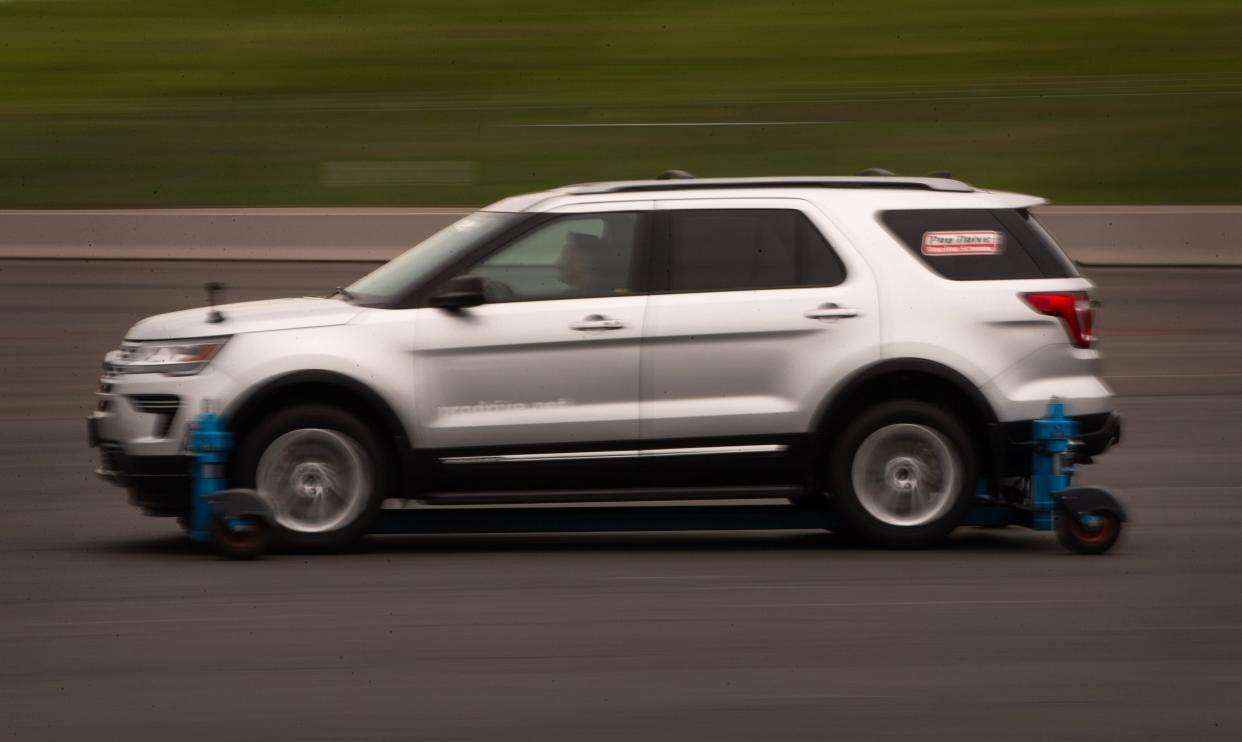Tips for driving in wet, snowy weather in Oregon and how to prepare
What's the most common mistake drivers make during the winter months? Overestimating their vehicle's capabilities and their own driving skills.
That's according to Todd Harris, president of the Pro Drive Racing School, who on Wednesday used a skid car to teach participants essential skills for navigating snowy and icy conditions during an event in Portland with the Oregon Department of Transportation.

November and December are busy months for crashes, according to ODOT.
Travelers on Oregon roads experience the most crashes every year in December, with more than 4,900 across the state annually over the past 10 years.
November follows close behind with an average of 4,555 crashes.
Harris talked about braking techniques, how to control skids and drive in wet conditions and understanding vehicle limitations.

5 key tips for winter driving in Oregon
Here are Harris's five tips for winter driving.
Reduce your speed.
Keep your eyes up, looking as far down the road as possible.
Use as smooth controls as you can with steering, gas and brake.
Brake in a straight line before making a turn around a corner.
Don't overestimate your car's driving capabilities or your own driving skills.
In order to stay as safe as possible while traveling during the winter, ODOT advises drivers carry a "go-bag" in their vehicles. Bag essentials include a first aid kit, extra food and water, a working flashlight, car tools and equipment, extra clothing and blankets, and anything else deemed necessary for travel.
Other essential items include a cellphone charger, ice scraper and snow brush, matches or a lighter, paper towels and extra washer fluid.
How to prepare and stay safe during winter travel
ODOT has provided the following tips for drivers to prepare and stay safe while traveling in the winter.
Make sure your vehicle is in good operating condition. This means keeping clean headlights, good brakes, working windshield wipers and tires with good tread.
Slow down when approaching off-ramps, bridges or shady spots where snow and ice may linger.
Use Tripcheck.com to map your route before traveling and start your trip with a full fuel tank or vehicle charge.
Never pass a snowplow or any winter maintenance truck.
Allow extra stopping distance. There's less traction on slick and snowy roads.
In bad visibility, being able to see is as important as being seen. Turn on your headlights to increase your visibility to others.
Carry chains and know how to use them.
If you're tired, don't fight it. Get a room if you can, wait out the storm and finish your trip when you feel refreshed.
Slow down and allow extra time to get where you're going.
ODOT says it can't clear roads as often during winter weather
ODOT recently announced it does not have enough funds to maintain the state's transportation system at the level needed to maintain road safety.
With operating costs increasing and fuels tax revenues declining, ODOT says it will have to scale back services around the state.
"We won't be able to clear roads during winter storms as quickly as in the past," said Mindy McCartt, spokesperson for Oregon Department of Transportation. "There may be more snow and ice buildup, more chain requirements and longer delays and more frequent road closures."
According to ODOT, the lack of road maintenance means drivers could see the following:
More potholes and ruts in the road, along with more trash in medians and along highways.
Longer wait times for roads to reopen after a crash, lower speed limits because of poor pavement conditions and fewer ODOT responders on the road.
During winter conditions, there will be more snow and ice build-up, more chain requirements, longer delays and fewer open roads.
While communities will see lower maintenance for roads, ODOT wants to make clear workers will be working as much as possible to keep roadways safe.
To report a hazard on state highways such as fallen trees and electric wires or a road blockage from mud or rocks, call the nearest ODOT dispatch center:
Portland metro area, Hood River area: 503-283-5859
Willamette Valley, north coast: 503-362-0457
Southern Oregon, south coast: 541-858-3103
Central and eastern Oregon: 541-383-0121
More tips on how to stay safe while traveling during the winter can be found at bit.ly/45Xs4Jl.
Haleigh Kochanski is a breaking news and public safety reporter for The Register-Guard. You may reach her at HKochanski@gannett.com
This article originally appeared on Register-Guard: Oregon winter driving: Tips for safety and how to prepare
